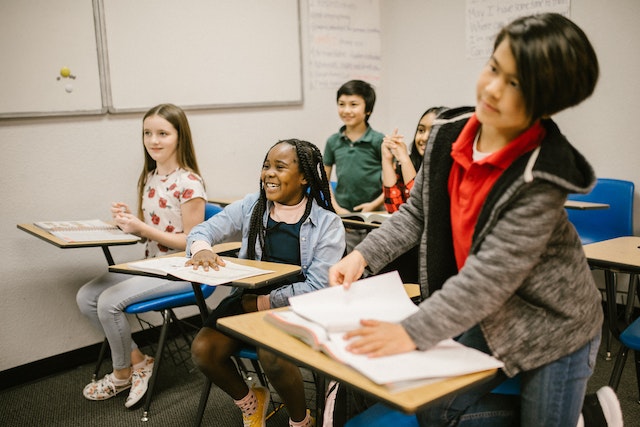Table of Contents
Creating effective class rosters is often a stressful duty for school staff. Schools often take the wrong approach by either including too many voices in the decision making process or swinging to the opposite extreme and having one staff member unilaterally make classroom placement decisions that are not to be questioned.
This article will discuss the research around creating an effective group of students for a school year and matching them with an appropriate teacher. Questions such as “Should students be grouped by ability level?”, “How can teacher input be considered without becoming onerous?” and “How should difficult or disruptive students be included?” and other questions will be answered here.
While there is no one perfect solution or even easy answer for making effective class rosters, research does suggest some key concepts to keep in mind when placing students. These ideas should be taken and considered by school staff and adapted for their individual situations, school cultures, and budgets.
Should Students Be Grouped By Ability?
Research on how students should be grouped is plentiful, but the answers provided seem to constantly contradict one another. The research tends to fall into one of two camps: streamed classrooms or mixed-level classrooms.
Streamed Classrooms
The first camp supports “the streamed approach”. In this approach, students are grouped as exactly and firmly by level as possible. Proponents of this approach say that it allows for less wasted teaching time as teachers can more easily design material and activities that will be equally useful for all students since they are all approximately at the same point in their learning.
There is some research to back this approach, for example this study showed that students preferred a streamed approach to having students of various levels in their classroom. (Joyce and McMillan) While this study was based on surveys rather than test scores, it still provides important insight into the benefits of simple streamed classrooms.
With a streamed classroom, teachers don’t have to spend time going over basics with lower level students while high level students sit there bored to death or similarly spend time on high level concepts while lower level students sit there dazed and confused. There is often also less frustration as everyone has a similar level of understanding and so there is little need to help other students catch up or students feeling like they are being held back by others in the room.
Streamed classrooms, as the name suggests, are streamlined and require minimal effort to manage or keep up. While this sounds like it would always be a good thing, there are those that say this overly simplified approach to teaching actually has invisible drawbacks that make them less effective.
Mixed-Ability Classrooms
Those who question the effectiveness of the streamed approach support “mixed-ability classrooms”. In a mixed ability classroom, students are all in a course that is appropriate for their learning goals, but each student may be at a notably different level of achievement at the course goals.
To clarify, this does not mean that a student in elementary school should be placed with someone learning high school algebra, but that two students working on high school level algebra might be able to benefit from being in the same classroom despite one being naturally gifted in the area while the other struggles. Proponents of the mixed-ability classroom are not suggesting the revival of the one room schoolhouse, but instead suggest that having multiple levels of achievement and different skill sets, perspectives, and personalities provides a more realistic working environment, provides opportunities for students to aid one another, and works to reduce discrimination.
Research into this approach has focused on how mixing many different types of students into one classroom helps to reduce inequality. For example, this study on mathematics classrooms in Californian high schools found that in mixed ability classrooms “differences in attainment between different cultural groups were eliminated in some cases and reduced in all others”. (Boaler)
The researchers showed that “students achieved at higher levels, learned good behaviour, and learned to respect students from different cultural groups, social classes, ability levels and sexes.” In addition to this the researchers noted that “Importantly, the goals of high achievement and equity were achieved in tandem through a mixed‐ability mathematics approach that is not used or well known in the UK.” (Boaler)
Why would mixing many students with such diverse needs actually lead to higher achievement? While this seems illogical, this is because too much focus is often put onto course materials rather than the learning that those materials elicit.
In a mixed ability classroom, students sometimes have work that is easy for them and other times have work that is rather difficult. This mirrors the real world where problems and challenges are not neatly streamlined and organized for consumption like many classroom’s highly polished curriculum.
While this makes sense that the lower level students would sometimes be given easy things suited for their level and sometimes the teacher would need to put in higher level content to meet the needs of the higher level students, wouldn’t higher level students always be unchallenged unless given materials that lower level students could not even begin to approach?
While higher level students should certainly have some materials and assignments that challenge them, their challenges should come from how they approach the work, the level of expertise expected from them, and differentiated instruction to help them move beyond simple classwork and take their high level skills into the real world.
In addition to the teacher helping high level students push themselves further to ensure they remain challenged, another hidden benefit is the fact that in mixed level classrooms, high level students often spend significant amounts of time explaining things or even tutoring classmates. This provides multiple benefits as it frees up teacher time to do more targeted teaching if they’re not having to hand hold low level students but also provides high level students with a chance to test their knowledge and competency by teaching others.
One of the largest problems in academia is that high level PhD scientists often lack the ability to explain their ideas in a way that is clear, simple, and digestible by the average person. This creates a large gap in science, medicine, and really any high level topic and the average individual which often misinterprets the poorly phrased and highly jargon filled explanations academics often publish.
Having experience in a mixed ability classroom provides highly intellectual children the chance to learn how others think, consider simpler ways to explain high level concepts, and learn to be more effective in not just learning for their own sake, but being able to pass their learning on to others. Learning that stays in one brain and then simply dies is useless, it is the ability of the student to turn that information into useful skills that separates those that are able to make a difference with their publications vs those who simply publish things that will only be read and cited by other academics and never make a difference in the real world.
There is a famous YouTube series where experts are brought on to discuss a high level topic at various levels from a way that a young child would understand to a discussion with another PhD level peer in their same field. As Einstein once said “If you can’t explain it to a six-year-old, then you don’t understand it yourself” – Albert Einstein.
Students who have a true grasp of concepts should be capable of not only putting correct answers on a test over the topic, but should be able to explain and put their understanding into practice. Though often uncomfortable and more difficult to manage, mixed level classrooms are a better mirror of the real world and prepare both high level and lower level students better for the challenges the world will present.
How to include teachers’ input?
Including feedback and ideas from multiple parties can quickly lead to a situation where there are too many cooks in the kitchen, so to speak. Sometimes it can feel simpler to just have one person divide up the students at random or based on their personal knowledge rather than trying to manage everyone’s expectations and desires.
While it is impossible to please everyone, not taking any input from teachers is a quick way to end up with every staff member being upset rather than just a few people with less than ideal situations. However, rather than trying to include every teacher in discussions of every detail like which students belong in which classes and with which students, they should be asked their opinions, concerns, and input through a survey at the end of the year.
In this survey, teachers can report students which they feel should not be paired, which students they would be highly suited for, and which students they may have a personal conflict with. This way, teachers can highlight specific cases of concern where there is a major issue without getting into the nitty gritty of hand picking every student in their class.
While many teachers will not know students from the previous year, these surveys are particularly useful for students with learning differences that are on ILPs. These students often have the same support staff through multiple years and their feedback on which teachers or classes they might be best suited for should be taken very seriously.
Of course, there will always be cases where students will have to be placed in a less than ideal situation, but having at least some feedback from teachers and applying that feedback when creating the roster whenever possible will minimize the amount of friction in classes and help teachers to feel that even though they might not get their ideal classes, their voice and opinion matters to administrators or the heads of their department.
It is important to be clear that the feedback received from teachers using the survey will be considered, but is not a guarantee. Teachers also need to be willing to be flexible with their class lists and realize that there will always be difficult students or people that seem to not be able to be paired with anyone else due to being a bit of a troublemaker.
In the end, the decisions must be respected by teachers, but in cases of health, safety, or serious conflict, administrators need to keep an open door to discuss class placements issues and make changes in the first weeks of school as no class roster will be perfect from day one.
Changes need to be made extremely rarely, however, or students and teachers will start to regularly come to ask for changes at the first sign of difficulty. Instead, there should be a process of attempting to solve the issues with the help or advice of staff before simply moving things around.
How should difficult students be placed in class rosters?
Many times, there will be a few students who receive multiple reports that they would not do well with basically any teacher or other classmates. This can happen when a student has behavior issues and those behavior issues cause other students to misbehave as well.
This can also happen with students who have particular learning difficulties. Oftentimes, it will seem like every possible teacher has requested to not have this student or for them not to be paired with almost anyone else due to their level or learning needs.
Obviously, they can not sit in a room by themselves, but making the decision of which class to put them in can be daunting as it will displease whoever gets them. There are two approaches here that may work depending on the school culture and staffing.
One approach is to try to place as many of these students who need extra help together and put a co-teacher to help manage behavior and give targeted learning support to those who need it. This co-teacher can be a second content expert or a learning support specialist or even a teaching aid, but simply having a second adult in the room makes classroom management significantly easier.
This approach has multiple benefits as this not only minimizes the number of classes affected by difficult students, it also provides a space with extra support for those who need it most. This can be a good approach for schools with a good learning support program or those with a lot of teaching staff.
However, not all schools have the luxury of being able to put two teachers into one single class and have reasonably sized classes. Additionally, this approach, if not done well, can lead to students feeling like they have been placed in the “dumb” class and hurt their motivation to try as they’ve already been marked as a failure.
Generally, it is best to spread out difficult students so that one teacher is not overwhelmed. While some teachers may be more suited to mixed-level teaching and learning support, it is important to not use this as an excuse to give that teacher every difficult student and burn them out.
While they may be able to take a couple more than the average, it is important that no teacher feels “above” having a challenging student. As mentioned above, learning to deal with a variety of different personalities and skill sets is good for both teachers and students to help them practice their skills in non-ideal situations.
Conclusion
While it is impossible to make everyone happy, there are definite steps that can be taken to create the most effective class rosters possible. Though many of the decisions, such as class sizes, will be decided by hiring decisions that are often out of the roster-maker’s hands, other choices should be carefully considered.
When thinking about making class rosters it is important to think about making well balanced classes that expose students to a variety of personality types and skill levels. Rather than trying to simply order students by scores or personalities, it is best to spread out students so that all teachers have a similar load and no teacher is overwhelmed and no student feels placed into the “smart” class or the “dumb” class.
Input can be taken from teachers and perhaps even students, but this should only be done once through a survey rather than a live discussion where no one will ever be satisfied. One survey to avoid major issues and try to make everyone happy is not a difficult thing and can make a huge difference in teachers and students feeling heard.
If this survey can keep the two boys who got into a fist fight last year apart, or make sure a teacher doesn’t have their own child who will not pay attention to their parent as well as another teacher, then it is worth the effort. In the end, however, issues will always arise and the door should be open to discussing these issues. Changes should be extremely rare however, in order to not create a precedent of students constantly jumping classes for the first months of school.
Difficult students can seem to have no place in school, but knowing a teacher who has a special relationship with them or helping them avoid the worst of their triggers can make a huge difference in a school year for a child. If one class does end up having a large number of challenging students, however, it is often good to place a co-teacher into that class.
Making an effective class roster is an extremely important decision, but also one that is impossible to do perfectly. Instead, it is best to focus on making balanced classes, seeking teacher input to avoid major conflicts, and ensuring that the most challenging students will have the support they need to be successful.
Want more like this? Make Lab to Class a part of your weekly professional development schedule by subscribing to updates below.
References
Boaler, Jo. “Promoting ‘Relational Equity’ and High Mathematics Achievement through an Innovative Mixed‐ability Approach.” British Educational Research Journal, vol. 34, no. 2, 2008, pp. 167–194, https://doi.org/10.1080/01411920701532145.
Joyce, Paul, and Brian McMillan. “Student Perceptions of Their Learning Experience in Streamed and Mixed-Ability Classes.” Language Education in Asia, vol. 1, no. 1, 2010, pp. 215–227, https://doi.org/10.5746/leia/10/v1/a18/joyce_mcmillan.




